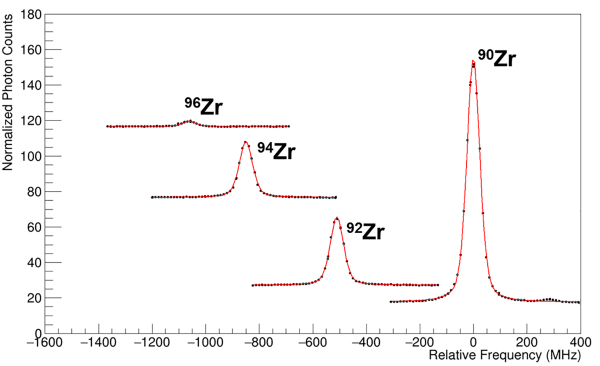Paul F. Mantica

Research
Nuclear Chemistry
(Research Description PDF)
The low-energy properties of atomic nuclei are predicted to show dramatic changes when the ratio of neutrons-toprotons in the nucleus becomes extremely unbalanced. My research group is working to deduce the electromagnetic properties of nuclei which have extreme neutron-to-proton ratios. The desired nuclei, which exist for only fractions of a second, are produced in very small quantities using intermediate-energy reactions at the National Superconducting Cyclotron Laboratory (NSCL) at Michigan State University.
Two electromagnetic properties of interest are the nuclear magnetic dipole moment and nuclear electric quadrupole moment. The dipole moment is sensitive to the orbital component of the angular momentum of any unpaired protons and/or neutrons in the nucleus. The dipole moment provides information on the nuclear quantum structure and the occupied single-particle states. The quadrupole moment is a measure of the deviation of the average charge distribution of the nucleus away from spherical symmetry. The shape of the collection of protons and neutrons in the nucleus, e.g. the nuclear collectivity or “deformation”, can be inferred from the quadrupole moment.
One way to deduce the electromagnetic moments of nuclei is via Collinear Laser Spectroscopy (CLS). The CLS method involves the co-propagation of a low-energy beam (~ 30 keV) of atoms/ions with laser light. Fixed-frequency laser light is Doppler tuned into resonance by varying the energy of the beam, with the subsequent fluorescence detected by a photomultiplier tube. The resulting hyperfine spectrum, a product of the interaction of atomic electrons with the nucleus, is analyzed to extract the nuclear magnetic dipole and electric quadrupole moments.
We have installed and commissioned a CLS beam line in the low-energy experimental area at NSCL as part of the Beam Cooling and Laser Spectroscopy (BECOLA) facility. The BECOLA facility also includes a cooler and buncher, which accepts the rare isotope beams from the NSCL beam thermalization area and converts them into a low-emittance, pulsed beam to improve the sensitivity of the CLS measurement. Stable beams of Ca, K, Sc, Mn, Fe, Ni, and Zr have been produced from off-line ion sources, and the hyperfine spectra have been collected and analyzed. The spectra collected for the stable, evenmass Zr isotopes are shown in the figure. We have also measured the hyperfine spectra for the short-lived radioisotopes 36,37K and 52,53Fe, produced at rates of 103 per second, with the goal of understanding the trends in charge radii in the vicinity of neutron shell closures. We plan to extend the reach of such studies with the implementation of a new pulsed laser system, whereby optical pumping will be used to preferentially populate an electronic state favorable for collinear laser spectroscopy.

Webpage
Area(s) of Interest
Nuclear (Nu)
Chemical Physics (CP)
Physical (Ph)
Selected Publications
First determination of ground state electromagnetic moments of 53Fe, A. J. Miller, K. Minamisono, D. M. Rossi, R. Beerwerth, B. A. Brown, S. Fritzsche, D. Garand, A. Klose, Y. Liu, B. Maass, P. F. Mantica, P. Mueller, W. Noertershaeuser, M. R. Pearson, and C. Sumithrarachchi, Phys. Rev. C 2017, 96, 054314.
Charge radii of neutron deficient 52,53Fe produced by projectile fragmentation, K. Minamisono, D.M. Rossi, R. Beerwerth, S. Fritzsche, D. Garand, A. Klose, Y. Liu, B. Maass, P.F. Mantica, A.J. Miller, P. Mueller, W. Nazarewicz, W. Noertershaeuser, E. Olsen, M.R. Pearson, P.-G. Reinhard, E.E. Saperstein, C. Sumithrarachchi, and S.V. Tolokonnikov, Phys. Rev. Lett. 2016, 117, 252501.
Population distribution subsequent to charge exchange of 29.85 keV Ni+ on sodium vapor, C.A. Ryder, K. Minamisono, H.B. Asberry, B. Isherwood, P.F. Mantica, A. Miller, D.M. Rossi, and R. Strum, Spectro. Acta B 2015, 113, 16.
Charge radii of neutron-deficient 36K and 37K, D. Rossi, K. Minamisono, H.B. Asberry, G. Bollen, B.A. Brown, K. Cooper, B. Isherwood, P. F. Mantica, A. Miller, D. J. Morrissey, R. Ringle, J. A. Rodriguez, C. A. Ryder, A. Smith, R. Strum, and C. Sumithrarachchi, Phys. Rev. C 2015, 92, 014305.
CV
B.S., 1985, Rensselaer Polytechnic Institute
Ph.D., 1990, Univ. of Maryland, College Park
DOE Postgraduate Research Training Program, 1990-93, Oak Ridge Associated Universities
Staff Scientist, UNISOR, 1993-95, Oak Ridge Associated Universities
Awards
| Year | Award | Organization |
|---|---|---|
| 2012 | Fellow of the American Physical Society | |
| 2011 | ACS Fellow | |
| 2011 | University Distinguished Professorship | |
| 2009 - 2010 | CIC Academic Leadership Program Fellow | Michigan State University |
| 2008 | Outstanding Academic Advisor Award | Michigan State University (College of Natural Science) |
| 2000 | CAREER Award | National Science Foundation (Division of Mathematical and Physical Sciences) |
| 2000 | University Teacher-Scholar Award | Michigan State University |